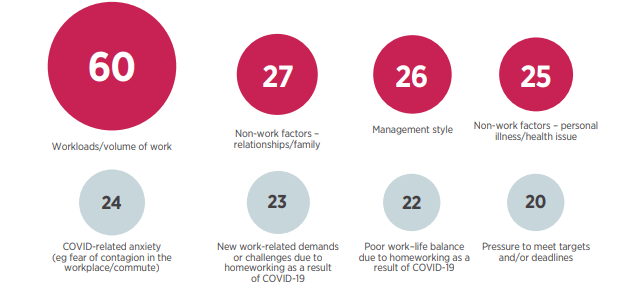
Are you freaking out with stress at work? And you are trying harder to contribute effectively and productively at work, but things need to be fixed. According to a survey conducted in 2000, among full-time employees in the US aged between 18-79 says that 60 % of the workers feel stressed at work. Work stress consequently affects the emotional, physical, and mental state of the person suffering from it.
Although workplace stress has increased, finding a low-stress job is difficult. Adopting good dealing strategies to reduce stress at your current job is a more realistic approach. You can reduce work stress by developing a positive morning routine, clarifying job requirements, implementing smarter time management techniques, and employing other strategies.
Under-Treatment Of Stress As An Issue
Mostly stress isn’t considered an important issue to be attended to; instead, it is deemed something people use when they are inefficient at work. According to a SHRM.org survey, as mentioned in the image below, only 35% of employees receive sufficient work resources. And only 41% are provided with resources to meet their mental health needs.
According to the HSE (Health and Safety Executive), 600,000 workers have reported stress, anxiety, or depression caused or excessive by work in the last 12 months.

Role of Managers at Workplace
As a workplace leader, you have a responsibility to your employees and a legal obligation to identify and reduce work-related stress and anxiety. Workplace pressure can be caused by a lack of development opportunities, poor management (or a lack of management), unrealistic deadlines and workloads, a lack of resources or equipment, and poor relationships with peers.
Your employee may be stressed because of non-work-related issues, but if they’re struggling at work, you have a duty of care to ensure that nothing in the working environment can be improved to help.
How Can Managers Ensure Availability For Employee Stress Management At The Interpersonal Level If Needed?
Everyone experiences stress due to increased demands from various sources, such as work, financial pressures, or interpersonal relationships. Anything the individual perceives as a real threat to their well-being can cause stress. A small amount of stress is often manageable, but when it becomes excessive, it can be harmful. A manager can communicate with his employees at an interpersonal level so that they can connect with him to understand their issues.
Traits Of A Manager At The Workplace
A quality trait of a manager is that his employees believe he will listen to them. You are responsible for a large part of successfully managing your team’s stress levels. With an excellent management style, your employees will see you as approachable, empathetic, and capable of building excellent rapport. A good manager will also be able to foster a healthy and productive work environment in which employees feel supported, valued, and rewarded.
Understanding Signs Of Your Employees
Stress can manifest in a variety of ways. Emotionally, it is most commonly expressed through tears, irritability, or anger. Look out for less obvious psychological signs, such as poor concentration, frequent mistakes, or someone being reticent. Let your team members know if you find out they are suffering from stress. Good relationships with workers, and one-to-one catch-ups, will provide the ideal opportunity for problems to be aired.
Here Are A Few Tips For A Manager To Ease Stress At The Workplace
The central dynamics behind managing stress remain the same, even at site or off-based. According to a CIPD absence survey, Managers work short-term (70%) and long-term (61%) absences in organizations. Six in ten (60%) provide managers with short-term absence management training, and (65%) provide them with tailored support. In addition to that, the report stated the most common reasons for stress at work are workload, non-work factors such as personal relationships or family-related problems, the style of management, and personal health issues.

It is critical to communicate with your employees regularly, regardless of where they are located. Frequent one-on-one meetings, informal conversations, colleagues’ feedback, and formal staff satisfaction surveys are essential. You can begin to improve things and reduce risk factors once you fully understand any issues in your workforce.
2. Consider Your Equipment, Resources, And Working Environment
Workers are frequently dissatisfied simply because of insufficient materials, software, equipment, or resources. A lack of appropriate tools can reduce both productivity and motivation.
Keep an eye on workloads and how people are handling them. And, if they’re not being as productive as you’d like, can you provide them with better resources to help them? Enable your employees by providing a pleasant work environment, and assess whether improvements can and should be made regularly.
3. Have Flexible Working Options
Companies of all sizes are increasingly providing flexible or remote working options. Engineers are among those who believe they could benefit from flexi-time or working from home on occasion, and where those options are viable, it’s worth considering them for your employees.
Employees who lack work/life balance are frequently the source of stress and strain in today’s fast-paced world. If you can help your employees regain control of their lives, you can significantly improve their well-being.
4. Identifying Workplace Stressors
What are the current requirements? Is the design of the work appropriate? Remember that changes to an open-plan environment or lighting, for example, may cause stress in some people. Ensure that your employees feel supported and heard. Maintain an ‘open door’ policy and tell them they can come to you with any problems. Examine and improve your listening skills so that you are the first to know if a problem arises.
5. Accomplish And Value Initiatives
Everyone wants to feel valued, and feeling undervalued can harm your employees’ mental health. While incentive programs and attractive benefits packages will always help with employee motivation, your initiatives do not have to break the bank.
Be inventive. Provide frequent and low-cost rewards and competitions within your teams, with prizes such as a free lunch, a bottle of wine, or an early Friday finish.
Don’t underestimate the power of a simple “thank you.” It’s sometimes all that’s required to boost a worker’s morale and reduce stress.
6. Encourage Well-Being And Health
As a leader, it is in your and your company’s best interests to ensure the well-being of your employees. Check to see if people are taking regular breaks and lunch breaks. Often, stress can be reduced simply by taking time out and taking a break from their tasks. Encourage mindfulness, relaxation techniques, and exercise as well. Organize group lunchtime walks or provides free fruit to your employees. A healthy body often leads to a healthy mind.
Concluding Remarks
The role of managers is essential in developing a stress-free environment that can optimize productivity and efficiency. Employees all over the world are taking steps to manage work-related stress better. Managers should remember that they are not medical experts but owe it to their organization and team to be their best managers. This includes recognizing, managing, and reducing stressful situations that may arise in the workplace. Employers are putting efforts into stress management and the well-being of the mental health of employees, which is commendable. Moreover, managers should also conduct workplace training programs for better employees’ emotional well-being.